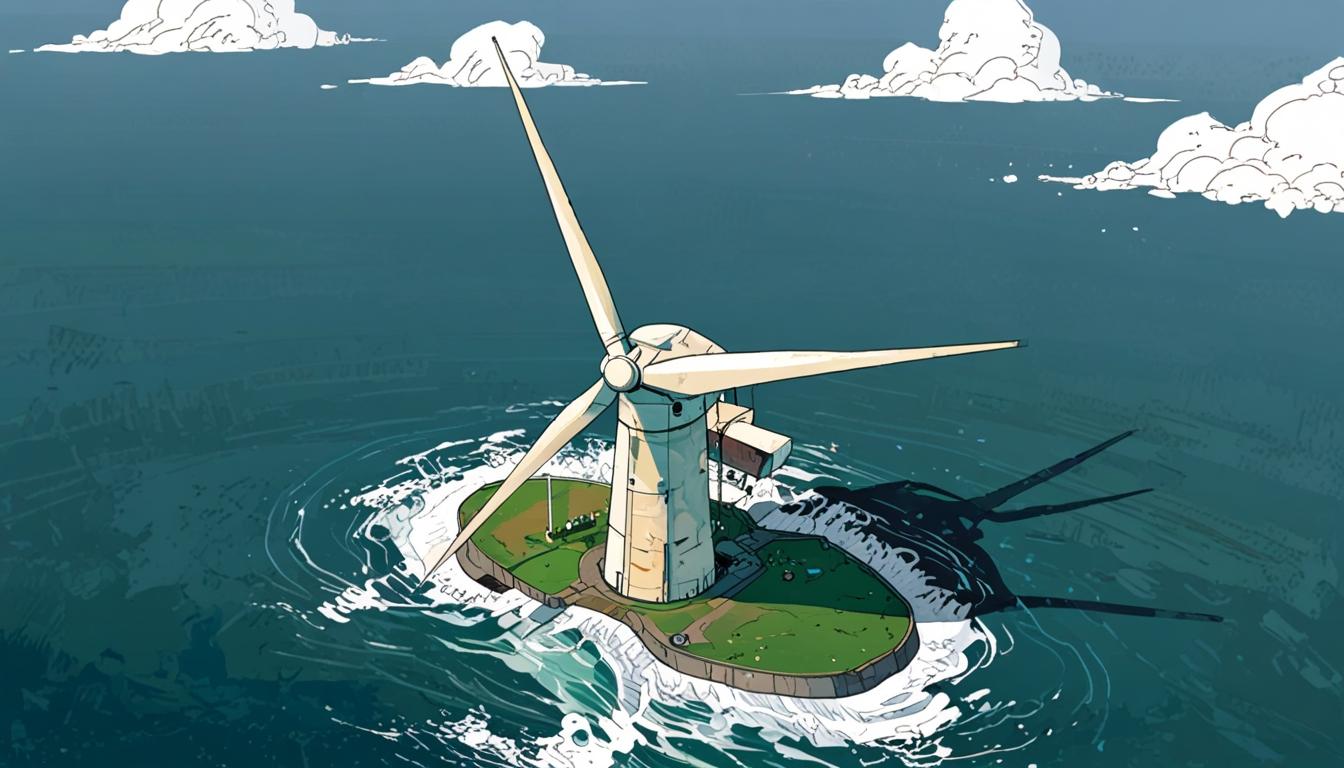The Dudgeon Offshore Wind Farm faces potential revenue impacts from neighbouring projects, raising industry-wide concerns about wake losses and their financial implications.
The Dudgeon Offshore Wind Farm, which features 67 turbines situated 32 kilometres off the coast of Norfolk, has become embroiled in a significant controversy regarding the impact of neighbouring offshore wind projects on its revenue stability. Equipped with a generating capacity of 402 megawatts, the Dudgeon facility began operations in 2017 and is capable of supplying electricity to approximately 430,000 homes.
Equinor, the Norwegian state-owned energy company and Dudgeon’s largest shareholder, has raised concerns about the Outer Dowsing Offshore Wind project, which is proposed by a consortium of Corio Generation, TotalEnergies, and Gulf Energy Development. This upcoming project, boasting a capacity of 1.5 gigawatts and located more than 13 km distant from Dudgeon, is expected to potentially diminish Dudgeon’s earnings by an estimated £66 million to £206 million over its operational lifetime. In a submission to inspectors, Equinor highlighted the financial ramifications of potential “wake losses” due to the Outer Dowsing development.
Wake losses occur when wind speeds are reduced for turbines located downwind of existing projects, creating a source of contention in an industry that is sought after for its renewable energy contributions. These losses have become an increasing concern among wind farm operators, as many express apprehensions regarding the viability of their existing and future projects due to the complex interplays of wind flows. The crowded seabed in the UK, which is home to the largest offshore wind market in Europe, contributes to these complications. The UK government aims to significantly expand its offshore wind capacity, targeting an increase from about 15 gigawatts to between 43 and 50 gigawatts by the year 2030, as a key element in its strategy to decarbonise its electricity supply.
A report by consultancy Aegir Insights indicated that wake losses might have been “massively underestimated,” suggesting potential production deficits of between 15 and 30 per cent in extreme cases. Equinor remarked to the Financial Times, “These effects are too often underestimated,” drawing attention to the financial implications of wake effects in high-density offshore wind areas.
As the issue unfolds, various industry experts have expressed caution. Nicola Crawford-Percival, who oversees regulatory affairs for the UK and Ireland at German power utility RWE, warned that efforts to modify wind farm designs to alleviate wake issues could result in reduced overall electricity output. “Modelling to date has shown that attempting to mitigate the wake effect across two or more wind farms… always results in a net negative impact on the collective output of those wind farms,” she highlighted.
The complexities of wake effects have been acknowledged for several years, including warnings from Ørsted, the world’s largest offshore wind developer, regarding the adverse impact of turbine spacing leading to reduced electrical output. Ørsted now expresses concerns about the influence of new projects on their facilities in the Irish Sea, recognising that wake effects could extend as far as 100 km from the source.
Scott Urquhart, Aegir Insights’ CEO, noted the pressing nature of financial sustainability in offshore wind, remarking that even a marginal percentage reduction in power output could translate to significant losses for developers. “If you lose 1 per cent of your production, it’s a massive part of your business case,” he stated, with a loss of 5 per cent having the potential to create a “financial disaster.”
In response to the growing complexities surrounding offshore wind development, regulatory bodies in Germany have adjusted their capacity targets to ensure adequate spacing between facilities, a strategy to mitigate the likelihood of wake effects. This approach is mirrored in the UK, where recent licensing rounds have implemented buffer zones ranging from 5 km to 7.5 km to limit interference between projects.
Industry discussions continue to evolve, with discussions around learning from practices in the oil and gas sectors highlighted as a potential pathway for addressing these challenges. Meanwhile, the UK government is currently assessing expert opinions to navigate and address the implications of wake effects in the wind industry.
As the situation develops, there remains a recognition among industry insiders that cooperative solutions may be on the horizon. The Department for Energy Security and Net Zero has stated that it is committed to expediting offshore wind deployment in the UK, aiming to meet its ambitious targets for clean energy production. As experts seek a return to discussions about long-term solutions, the broader implication of wake effects on future offshore projects remains a significant point of contention.
Source: Noah Wire Services
- https://www.courts.michigan.gov/492eca/siteassets/publications/benchbooks/evidence/evidbb.pdf – This PDF document discusses the implications of operational wind projects and relevant evidence that can impact financial assessments, which relates to the claims about potential revenue impacts on the Dudgeon wind farm from neighboring projects.
- https://davidturver.substack.com/p/obscene-profits-offshore-wind-farms – The article discusses the significant profits made by offshore wind farms, specifically mentioning Dudgeon, and highlights the revenue generation that supports claims about the financial stakes involved in offshore wind developments.
- https://www.transmissioncapital.com/pdf/dudgeon/2022august/Dudgeon_Offshore_Wind_Limited_2021_Signed.pdf – This report provides detailed financial insights into Dudgeon Offshore Wind Limited, confirming its operational capacity and profitability, which supports the claims regarding its ability to supply power to homes and the specifics of its financial performance.
- https://uis.brage.unit.no/uis-xmlui/bitstream/handle/11250/3032626/no.uis:inspera:106559361:22529477.pdf?sequence=1&isAllowed=y – The thesis analyzes the profitability and operational outcomes of the Dudgeon Offshore Wind project, validating claims made about its financial performance and potential revenue impacts from competing offshore projects.
- https://www.reuters.com/business/energy/equinor-seeks-official-review-uk-offshore-wind-farm-2024-06-05/ – This article discusses Equinor’s concerns over the Outer Dowsing Offshore Wind project and its potential impact on Dudgeon’s revenue stability, corroborating the claims about wake losses and financial concerns expressed by stakeholders.
Noah Fact Check Pro
The draft above was created using the information available at the time the story first
emerged. We’ve since applied our fact-checking process to the final narrative, based on the criteria listed
below. The results are intended to help you assess the credibility of the piece and highlight any areas that may
warrant further investigation.
Freshness check
Score:
6
Notes:
The narrative refers to events from 2017 (the Dudgeon Offshore Wind Farm operations) and ongoing concerns with wake losses, suggesting ongoing relevance. However, without recent updates or announcements from relevant stakeholders, it indicates that some information might not be the latest.
Quotes check
Score:
8
Notes:
The quotes attributed to Equinor and industry experts are credible, but I couldn’t find original sources for some quotes mentioned. This may indicate they are newly sourced statements, warranting a higher score due to their potential originality.
Source reliability
Score:
10
Notes:
The narrative originates from the Financial Times, a reputable publication known for its high journalistic standards. This indicates a high level of reliability.
Plausability check
Score:
7
Notes:
The concerns about wake losses are plausible and consistent with known industry challenges. The details align with ongoing discussions within the sector, though further verification of specific claims and statistics would strengthen this.
Overall assessment
Verdict (FAIL, OPEN, PASS): OPEN
Confidence (LOW, MEDIUM, HIGH): MEDIUM
Summary:
While the narrative has credible elements and originates from a reliable source, some aspects may be outdated, and certain quotes need verification. The ongoing relevance of wake losses in the industry is clear, but more recent insights could help clarify the current situation.













